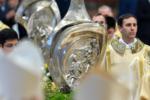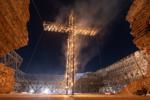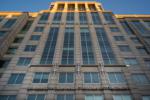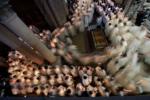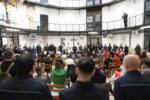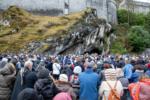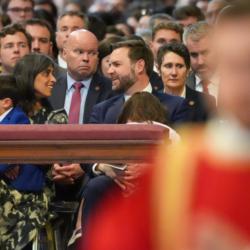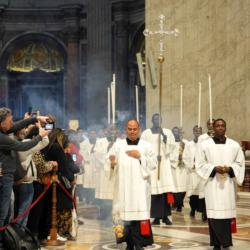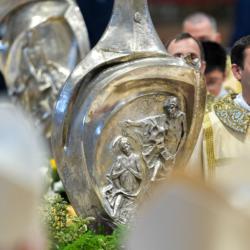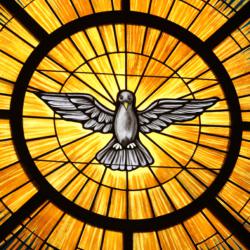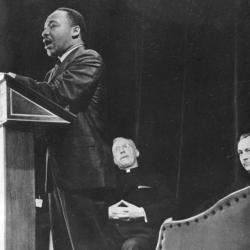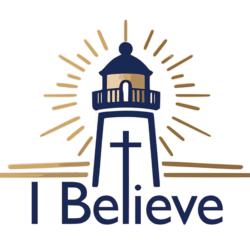Collector shares passion for relics with local parishes
TYNGSBOROUGH -- Jim Robson has always loved collecting.
As a child, he collected coins, antique bottles, and photographs. For the past 25 years, he has collected relics of over 100 saints, and artifacts of Christ's life and passion.
"The reverence you have to give them is the utmost," Robson, 67, said. "Literally, they are the body of Christ in Heaven. So right now, because they're here, Jesus is here."
For five years, under the name Saints Be to God, Robson has traveled with his collection of relics throughout the Archdiocese of Boston. Saints Be to God's business cards are themselves third-class relics. Robson visited St. Mary Magdalen Parish in Tyngsborough on April 14, the Monday of Holy Week, with relics of the passion: Pieces of the Crown of Thorns, the Holy Sponge, Calvary, the table of the Last Supper, St. Longinus, and the Tomb of Jesus, to name a few.
Almost all of the relics are small enough to fit on the head of a pin. When it comes to relics, Robson said, "size doesn't matter."
"I'm just blessed to have these extremely small samples, but at the same time, the graces of God are just astronomical," he said.
When they're not on public display, the relics have a place of honor in his home. He is surrounded by saints every day of his life.
"That feeling brings a joy to your heart that's not really explainable," he said. "To think that I can look up and see and talk to St. Mary Magdalene or St. John Paul II or any of these saints, is just a joyful heartfelt feeling, and honestly, hard to put into words."
Several came to St. Mary Magdalen to venerate Robson's relics, including a relic of the church's namesake. Brandon Barrientos brought a Market Basket bag full of icons and crucifixes to make into third-class relics.
In the Catholic Church, relics are categorized into three main "classes": First class relics are physical remains of a saint, as well as items related to Christ's life or Passion, such as relics of the True Cross. Second class relics are items that belonged to a saint, like vestments or prayer books. Objects that are touched to a first or second class relic become third class relics.
"This week is very important to millions of people, and to have the chance to have a tangible experience to really solidify what this week means is a blessing, and I didn't want to miss out," Barrientos told The Pilot.
He said that Robson's exhibition "puts a face" on what he learned in faith formation.
"It's very overwhelming," he said. "I can't begin to express how at peace and at awe I am to be able to see these different relics."
Robson's collection began when Sister Margaret Mary, a Slave of the Immaculate Heart of Mary who lived at the St. Benedict Center in Still River, gave him a small reliquary containing fragments of the Pillar of Scourging and the Holy House of Loreto. His collection grew from there.
"The fact that I started to find some of these was quite overwhelming," he said.
He consulted with multiple spiritual directors about what he should do with the relics. They told him that it was okay for him to take care of them, as long as he put them on display to be properly venerated.
"Most of these, if they're not in a church setting, they could end up in a drawer or something like that, which is totally inappropriate," he said.
Relics typically come with documentation confirming their authenticity. Most of the relics were documented and verified by Father Carlos Martins, the only priest in North America who has permission from the Vatican to repair and authenticate relics.
"He goes through all the techniques that he was taught by the Vatican," Robson said of Father Martins. "They have to have a seal, and they have to have a document to verify that they're real. Even those can be reproduced or finagled, so you have to be very careful."
In turn, Father Martins gave Robson permission to "rescue" relics. Relics are often bought and sold, which, according to the Code of Canon Law, "is absolutely forbidden."
"Places like eBay are not a good source of relics," Robson said. "You don't know if they're real or not."
He has found relics in "almost any place you can find things." He credits the grace of God for every discovery. One of his favorite relics, a piece of the name of Jesus posted on the cross, was found in a pile of other relics.
"Most of the time they need some help," he said. "They need to be preserved."
Others were gifts. A priest once gave him relics that had been damaged in a sacristy fire. A sister gave him a piece of Mary's veil after he helped her move a paschal candle after Mass. That relic is now on display in a Holy Family Reliquary, along with a piece of St. Joseph's mantle and a pebble from the stable at Bethlehem.
"Being able to actually allow people to hold something or hug a saint, it's just an amazing grace that is so very fruitful," Robson said.
He grew up attending parochial school and voraciously reading about the lives of the saints.
"That's part of what I want to be," he said. "I want to be a dedicated follower of Jesus."
He is particularly devoted to St. Francis and St. Dismas. The latter's relic was on display at St. Mary Magdalen Parish.
"I would never have thought I would be able to get a relic of his, he said, adding: "He's fabulous."
Robson said that due to his "Franciscanism," he's been able to find many relics of Franciscan and Capuchin saints. He has one reliquary containing 14 different capuchins, including "some wonderful saints."
He said that some of the people who came to see his relics reported being healed afterwards. Once, when he took his collection to Massachusetts General Hospital, a woman who was due to enter hospice care encountered the relics and made a full recovery. He attributed it to "the powerful intercession of the saints and the healing power of Jesus."
"By his stripes, we are healed," he said. "I firmly believe that."

